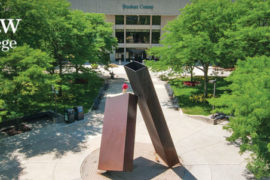Scio Township Trustee Irwin Martin and Barry Lonik of Treemore Ecology and Land Services Inc., explain the growing movement of land preservation through conservation easements.
There are 25 land preservation projects completed with Scio Township’s dedicated land preservation millage.
Eleven of these are either owned by the township or Washtenaw County Parks as preserves. The remaining 14 properties have “conservation easements” recorded as deed restrictions in the title work of the property.
Nice couple of words, but what exactly are conservation easements and how do they work?
When a person or entity owns property a number of property rights are included. Some property rights allow the property owner to “develop” the land in different ways. As long as local zoning requirements are met, a property owner may choose to divide property into smaller parcels to sell, or to build and sell houses on those smaller parcels. The property owner may opt to clear the land or operate a business.
These are collectively referred to as the “development rights.” A landowner can pursue the permitted activities allowed by local zoning regulations or they can convey their development rights to another party such as Scio Township. To qualify for programs that purchase rights, and enjoy the federal income tax deductions for donating some or all of the value of development rights, the rights must be conveyed in perpetuity in a deed restriction called a “conservation easement.”
Conservation easements identify the property to be “conserved” with a legal description provided by a surveyor and the “conservation values” to be protected. Conservation values can include natural habitats, agricultural soils, scenic views, biological diversity, landscape-level ecosystems and mosaics, protection of rare, threatened, or endangered ecosystems, habitats, etc.
The “guts” of the easement are the sections that specify which rights are being retained by the landowner and named “Permitted Uses” and those that are being relinquished by the property owner, called “Prohibited Actions”. As grantee or beneficiary of the conservation easement, it is Scio’s responsibility to ensure the agreement is upheld— forever.
There is a section in the conservation easement language specifying the township’s right to enter the property after proper notice to the property owner, to document any changes, permitted or not, and to pursue “remedies” for the property to be returned to its previous condition if a use not permitted was undertaken.
Township staff visits the property once a year to “monitor” its condition, which also builds awareness and understanding with the landowner and usually avoids any issues. In the event the property is in violation of the terms of the conservation easement the township as grantee could pursue a number of enforcement actions to require the property be restored, including taking the landowner to court. Once the parties have agreed to easement terms, the owner/ grantor and the township/grantee sign the document and it is recorded in the county Register of Deeds.
All current and future landowners must abide by the agreement.
Amendments to the conservation easement are only permitted to clarify language, move a permitted use or structure to another location, forego a permitted use and respond to a change in agricultural technology. While the township is “purchasing” development rights, we don’t “own” them and can’t use them. The legal term is that we “retire” the rights so they can no longer be used. The only way rights could be used is if they were reunited with the title to the property. That is, if the easement grantee was going to also take ownership.
There is a section of the easement stating if that is ever to occur, the easement must be conveyed to another agency, such as Washtenaw County Parks, so the “merger” of easement and title doesn’t happen. The new grantee agency would then be responsible for monitoring and enforcement of the easement.
The value of development rights is determined by an independent real estate appraiser. The appraiser produces two reports, one for the property “as is” with its development potential intact and a second with the conservation easement in place. In both cases the “subject” property is compared to similar, nearby properties that have sold in the recent past. After adjustments are made for property size, location, type of road frontage, time since the sales occurred, etc., the appraiser provides a professional opinion of the values of the subject.
The difference between the “before” and “after” appraisals is the value of development rights. That difference is usually the price paid, although in many cases the landowner discounts the sale price or even donates the entire value. In such cases, the landowner is eligible to declare the discounted amount or the value of donated rights as a deduction on their federal income taxes. Federal income tax law allows for the deduction to be spread over as many as 16 years.
For more information, please contact your accountant or Township office staff who can refer you to expert advisors.
Conservation easements have many benefits. They protect land from development. Since the property remains in private ownership, unlike properties purchased as preserves, the owner keeps paying taxes. Often, real estate taxes paid by the landowner decrease as the assessed value of the land without development rights is lower.
Purchasing easements also costs less than buying land so our dedicated, but limited, millage funds go further. For properties in agricultural use, local jobs are supported. For these and many other reasons, conservation easements will continue to be a valuable tool for Scio Township’s land preservation program.
For further information, please contact the Township staff. We will happy to direct your questions to the appropriate expert.











